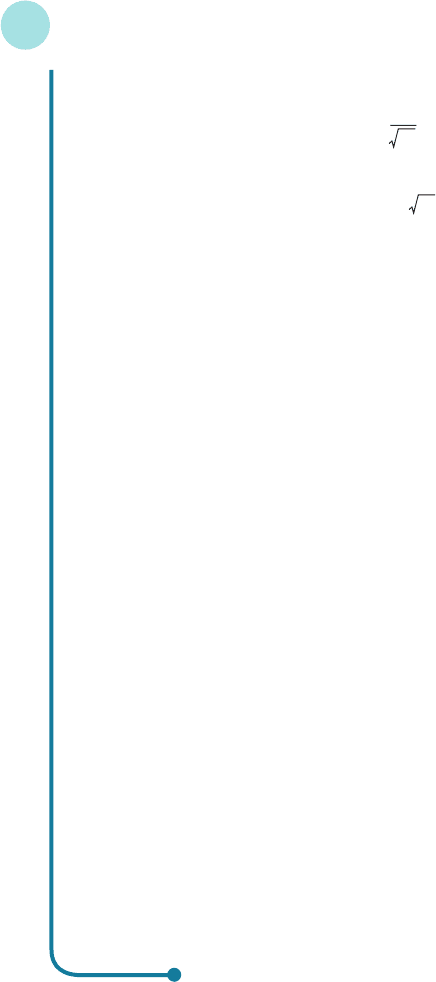Jacques I. Mathematics for Economics and Business
Подождите немного. Документ загружается.


10 Find the consumer’s surplus at P = 5 for the following demand functions:
(a)
P = 25 − 2Q (b) P =
11 Find the producer’s surplus at Q = 9 for the following supply functions:
(a)
P = 12 + 2Q (b) P = 20 Q + 15
12 Given the demand function
P =−Q
2
D
− 4Q
D
+ 68
and the supply function
P = Q
2
S
− 2Q
S
+ 12
find
(a) the consumer’s surplus
(b) the producer’s surplus
assuming pure competition.
13 If the net investment function is given by
I(t) = 100e
0.1t
calculate
(a) the capital formation from the end of the second year to the end of the fifth year
(b) the number of years required before the capital stock exceeds $100 000.
14 Find the expression for capital formation between t = 0 and t = T for the following net investment
functions:
(a)
I(t) = At
α
(b) I(t) = Ae
αt
where A and α are positive constants.
15 Calculate the present value of a continuous revenue stream of $1000 per year if the discount rate is
5% and the money is paid
(a) for 3 years (b) for 10 years (c) for 100 years (d) in perpetuity
16 The present value of a continuous revenue stream of $5000 per year with a discount rate of 10%
over n years is $25 000. Find the value of n correct to 1 decimal place.
10
Q
Integration
450
MFE_C06b.qxd 16/12/2005 11:21 Page 450

chapter 7
Matrices
The impression that you may have gained from reading this book is that mathematics
consists of one main topic, calculus, and that every other topic is just a variation on
this theme. This is far from the truth and in this chapter and the next we look at
two refreshingly different branches of mathematics. It would be useful for you to
have studied Chapter 1, although even this is not essential. There are four sections.
It is essential that Sections 7.1 and 7.2 are read first, but the remaining sections can
be read in either order.
Section 7.1 introduces the concept of a matrix, which is a convenient mathematical
way of representing information displayed in a table. By defining the matrix opera-
tions of addition, subtraction and multiplication it is possible to develop an algebra
of matrices. Simple economic examples are used to illustrate these definitions and
it is shown that the rules of matrix manipulation are almost identical to those of
ordinary arithmetic. In Section 7.2 you are shown how to calculate the inverse of a
matrix. This is analogous to the reciprocal of a number and enables matrix equations
to be solved. In particular, inverses provide an alternative way of solving systems of
simultaneous linear equations and so can be used to solve problems in statics.
Section 7.3 describes Cramer’s rule for solving systems of linear equations. This
method is a particularly useful way of solving economic models where only a
selection of endogenous variables need to be determined.
In Section 7.4 we discuss a new economic topic known as input–output analysis and
show how the matrix operations described in the first two sections can be used to
determine the flow of money between firms.
MFE_C07a.qxd 16/12/2005 10:45 Page 451

MFE_C07a.qxd 16/12/2005 10:45 Page 452

section 7.1
Basic matrix operations
Suppose that a firm produces three types of good, G1, G2 and G3, which it sells to two cus-
tomers, C1 and C2. The monthly sales for these goods are given in Table 7.1. During the month
the firm sells 3 items of G2 to customer C1, 6 items of G3 to customer C2, and so on. It may well
be obvious from the context exactly what these numbers represent. Under these circumstances
it makes sense to ignore the table headings and to write this information more concisely as
A =
J
K
L
734
156
G
H
I
Objectives
At the end of this section you should be able to:
Understand the notation and terminology of matrix algebra.
Find the transpose of a matrix.
Add and subtract matrices.
Multiply a matrix by a scalar.
Multiply matrices together.
Represent a system of linear equations in matrix notation.
Table 7.1
Monthly sales for goods
G1 G2 G3
Sold to C1 734
customer C2 156
MFE_C07a.qxd 16/12/2005 10:45 Page 453

Matrices
454
Practice Problem
1 Let
A = B = [1 −1062] C = D = [6]
(a) State the orders of the matrices A, B, C and D.
(b) Write down the values of
a
11
, a
22
, b
14
, c
25
, c
33
, c
43
, d
11
J
K
K
L
10231
57902
34678
G
H
H
I
J
K
L
12
34
G
H
I
which is an example of a matrix. Quite generally, any rectangular array of numbers surrounded
by a pair of brackets is called a matrix (plural matrices) and the individual numbers constitut-
ing the array are called entries or elements. In this book we use square brackets, although it is
equally correct to use parentheses (that is, round brackets) instead. It helps to think of a matrix
as being made up of rows and columns. The matrix A has two rows and three columns and is
said to have order 2 × 3. In general, a matrix of order m × n has m rows and n columns.
We denote matrices by capital letters in bold type (that is, A, B, C, . . .) and their elements
by the corresponding lower-case letter in ordinary type. In fact, we use a rather clever double
subscript notation so that a
ij
stands for the element of A which occurs in row i and column j.
Referring to the matrix A above, we see that
a
12
= 3 (row 1 and column 2 of A)
A general matrix D of order 3 × 2 would be written
Similarly, a 3 × 3 matrix labelled E would be written
J
K
K
L
e
11
e
12
e
13
e
21
e
22
e
23
e
31
e
32
e
33
G
H
H
I
J
K
K
L
d
11
d
12
d
21
d
22
d
31
d
32
G
H
H
I
Example
Let
B = C =
(a) State the orders of the matrices B and C.
(b) Write down the values of b
22
and c
34
.
Solution
(a) Matrices B and C have orders 2 × 2 and 3 × 4 respectively.
(b) b
22
= 6 (row 2 and column 2 of B)
c
34
= 7 (row 3 and column 4 of C)
J
K
K
L
1340
1211
1457
G
H
H
I
J
K
L
21
−16
G
H
I
MFE_C07a.qxd 16/12/2005 10:45 Page 454

All we have done so far is to explain what matrices are and to provide some notation for
handling them. A matrix certainly gives us a convenient shorthand to describe information
presented in a table. However, we would like to go further than this and to use matrices to solve
problems in economics. To do this we describe several mathematical operations that can be
performed on matrices, namely
transposition
addition and subtraction
scalar multiplication
matrix multiplication.
One obvious omission from the list is matrix division. Strictly speaking, it is impossible to
divide one matrix by another, although we can get fairly close to the idea of division by defining
something called an inverse, which we consider in Section 7.2.
7.1 • Basic matrix operations
455
Advice
If you have not met matrices before, you might like to split this section into two separate
parts. You are advised to work through the material as far as 7.1.4 now, leaving matrix
multiplication for another session.
7.1.1 Transposition
In Table 7.1 the rows correspond to the two customers and the columns correspond to the
three goods. The matrix representation of the table is then
A =
The same information about monthly sales could easily have been presented the other way
round, as shown in Table 7.2. The matrix representation would then be
B =
We describe this situation by saying that A and B are transposes of each other and write
A
T
= B
J
K
K
L
71
35
46
G
H
H
I
J
K
L
734
156
G
H
I
Table 7.2
Sold to customer
C1 C2
Monthly G1 71
sales for G2 35
goods G3 46
MFE_C07a.qxd 16/12/2005 10:45 Page 455

or equivalently
B
T
= A
The transpose of a matrix is found by replacing rows by columns, so that the first row becomes
the first column, the second row becomes the second column, and so on. The number of rows
of A is then the same as the number of columns of A
T
and vice versa. Consequently, if A has
order m × n then A
T
has order n × m.
Matrices
456
Example
Write down the transpose of the matrices
D = E =
Solution
The transpose of the 3 × 4 matrix D is the 4 × 3 matrix
D
T
=
The transpose of the 2 × 1 matrix E is the 1 × 2 matrix
E
T
= [−63]
J
K
K
K
K
L
125
741
069
302
G
H
H
H
H
I
J
K
L
−6
3
G
H
I
J
K
K
L
1703
2460
5192
G
H
H
I
Practice Problem
2 Write down the transpose of the following matrices:
A =
B = [1 5 7 9]
C =
J
K
K
L
123
245
356
G
H
H
I
J
K
K
K
K
L
1401 2
3761 4
2135−1
2 −518 0
G
H
H
H
H
I
There are two particular shapes of matrices which are given special names. A matrix that has
only one row, such as
c = [521−4]
MFE_C07a.qxd 16/12/2005 10:45 Page 456

is called a row vector, and a matrix that has only one column, such as
d =
is called a column vector. It is standard practice to identify vectors using lower-case rather than
upper-case letters. In books they are set in bold type. If you are writing them down by hand
then you should underline the letters and put
c
(or possibly y) and d (or possibly z)
This is a useful convention since it helps to distinguish scalar quantities such as x, y, a, b, which
denote single numbers, from vector quantities such as x, y, a, b, which denote matrices with
one row or column. Incidentally, it is actually quite expensive to print column vectors in books
and journals since it is wasteful on space, particularly if the number of elements is large. It is
then more convenient to use the transpose notation and write the vector horizontally. For
example, the 7 × 1 matrix d given above would be printed as
d = [ −3106−7192]
T
where the superscript T tells us that it is the column vector that is intended.
7.1.2 Addition and subtraction
Let us suppose that, for the two-customer three-product example, the matrix
A =
gives the sales for the month of January. Similarly, the monthly sales for February might be
given by
B =
This means, for example, that customer C1 buys 7 items of G1 in January and 6 items of G1 in
February. Customer C1 therefore buys a total of
7 + 6 = 13
items of G1 during the two months. A similar process can be applied to the remaining goods
and customers, so that the matrix giving the sales for the two months is
C =
=
We describe this by saying that C is the sum of the two matrices A and B and we write
C = A + B
J
K
L
13 5 5
1910
G
H
I
J
K
L
7 + 63 + 24 + 1
1 + 05 + 46 + 4
G
H
I
J
K
L
621
044
G
H
I
J
K
L
734
156
G
H
I
J
K
K
K
K
K
K
K
K
K
L
−3
10
6
−7
1
9
2
G
H
H
H
H
H
H
H
H
H
I
7.1 • Basic matrix operations
457
MFE_C07a.qxd 16/12/2005 10:45 Page 457

In general, to add (or subtract) two matrices of the same size, we simply add (or subtract) their
corresponding elements. It is obvious from this definition that, for any two m × n matrices,
A and B,
A + B = B + A
because it is immaterial which way round two numbers are added. Note that in order to com-
bine matrices in this way it is necessary for them to have the same order. For example, it is
impossible to add the matrices
D = and E =
because D has order 2 × 2 and E has order 3 × 2.
J
K
K
L
12
11
35
G
H
H
I
J
K
L
1 −7
13
G
H
I
Matrices
458
Example
Let
A = and B =
Find
(a) A + B (b) A − B (c) A − A
Solution
(a) A + B =+=
(b) A − B =−=
(c) A − A =−=
J
K
K
L
00
00
00
G
H
H
I
J
K
K
L
9 −3
41
20
G
H
H
I
J
K
K
L
9 −3
41
20
G
H
H
I
J
K
K
L
4 −5
5 −5
−1 −4
G
H
H
I
J
K
K
L
52
−16
34
G
H
H
I
J
K
K
L
9 −3
41
20
G
H
H
I
J
K
K
L
14 −1
37
54
G
H
H
I
J
K
K
L
52
−16
34
G
H
H
I
J
K
K
L
9 −3
41
20
G
H
H
I
J
K
K
L
52
−16
34
G
H
H
I
J
K
K
L
9 −3
41
20
G
H
H
I
The result of part (c) of this example is a 3 × 2 matrix in which every entry is zero. Such a
matrix is called a zero matrix and is written 0. In fact, there are lots of zero matrices, each cor-
responding to a particular order. For example,
[0]
are the 1 × 1, 2 × 2, 4 × 1 and 4 × 6 zero matrices respectively. However, despite this, we shall
use the single symbol 0 for all of these since it is usually clear in any actual example what the
J
K
K
K
K
L
000000
000000
000000
000000
G
H
H
H
H
I
J
K
K
K
K
L
0
0
0
0
G
H
H
H
H
I
J
K
L
00
00
G
H
I
MFE_C07a.qxd 16/12/2005 10:45 Page 458

order is and hence which particular zero matrix is being used. It follows from the definition of
addition and subtraction that, for any matrix A,
A − A = 0
A + 0 = A
The role played by the matrix 0 in matrix algebra is therefore similar to that of the number 0
in ordinary arithmetic.
7.1 • Basic matrix operations
459
Practice Problem
3 Let
A = B = C = D = 0 =
Find (where possible)
(a)
A + D (b) A + C (c) B − C (d) C − 0 (e) D − D
J
K
L
0
0
G
H
I
J
K
L
−62
1 −9
G
H
I
J
K
L
2
2
G
H
I
J
K
L
5
4
G
H
I
J
K
L
75
21
G
H
I
7.1.3 Scalar multiplication
Returning to the two-customer three-product example, let us suppose that the sales are the
same each month and are given by
A =
This means, for example, that customer C1 buys 7 items of G1 every month, so in a whole year
C1 buys
12 × 7 = 84
items of G1. A similar process applies to the remaining goods and customers, and the matrix
giving the annual sales is
B ==
Matrix B is found by scaling each element in A by 12 and we write
B = 12A
In general, to multiply a matrix A by a scalar k we simply multiply each element of A by k.
J
K
L
84 36 48
12 60 72
G
H
I
J
K
L
12 × 7 12 × 3 12 × 4
12 × 1 12 × 5 12 × 6
G
H
I
J
K
L
734
156
G
H
I
Example
If
A =
find
(a) 2A (b) −A (c) 0A
J
K
K
L
123
456
789
G
H
H
I
MFE_C07a.qxd 16/12/2005 10:45 Page 459
